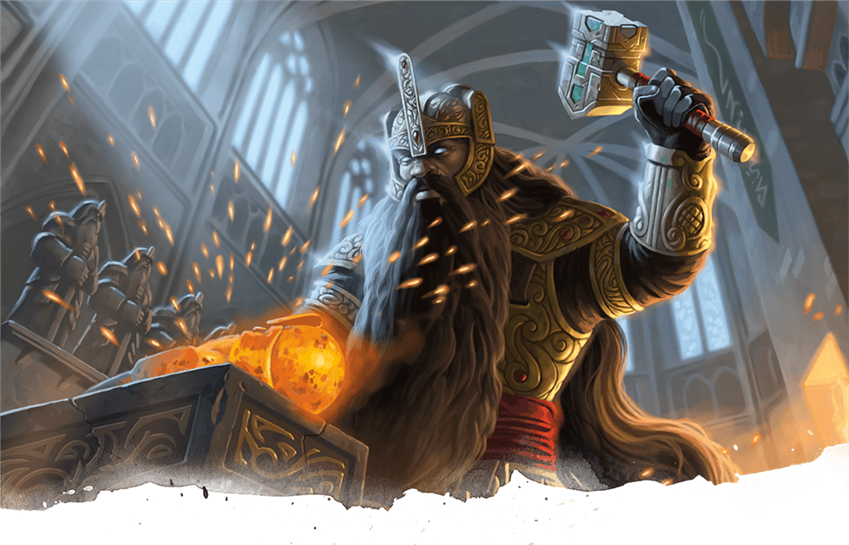We’ve now completed a third rotation of the Player’s Handbook, meaning that almost every class has had every subclass from that book examined in the Class 101 series! Two classes with lots of subclasses—the cleric and wizard—will need a little extra time to cover. Starting this week, however, we’re moving away from the Player’s Handbook and taking a look at the brand-new subclasses that you’ll find in Tasha’s Cauldron of Everything!
The first new subclass from Tasha’s is also from the game’s newest class: the artificer. This subclass, the Armorer, is a favorite of both Todd Kenreck and myself, because of the way they straddle the line of fantasy and science fiction with their magical power armor.
Artificers are most common in the world of Eberron, as described in Eberron: Rising from the Last War. However, artificers of some sort can be found all throughout the D&D multiverse. You can find artificers in the Forgotten Realms on the isle of Lantan, among the gnomes of Hupperdook in Wildemount, and filling all levels of prestige within the ranks of the Izzet League on the world-city of Ravnica—just to name a few settings where artificers can be found. If you’re playing D&D in another world or in a homebrew setting, talk with your Dungeon Master about how you could integrate artificers into this world.
Check out the other guides in the Class 101 series, like the broad overview of the artificer class in Artificer 101: A Beginner’s Guide to Making Magical Marvels, or a deep dive into a specific subclass in Artificer 101: Alchemist. If you’re interested in playing other classes, check out the entire Class 101 series.
Story of the Armorer
“And that is the Mark 1 Guardian.” A half-orc dressed in oil-covered clothing whistled in awe. Her hair was pulled into a high ponytail and her biceps glistened under the light of the forge. She turned to the hobgoblin beside her, who looked on in awe at the suit of steel plate armor that hung on the wall before them both. “I’m afraid it’s for personal use only. Not for sale.”
“Your pièce de résistance?” the hobgoblin replied gruffly.
“My masterpiece,” the armorer replied proudly. “But I’m not so precious to think that it’s perfect. You can see that I haven’t bothered polishing it.” Just as she said, the armor was rough, unfinished, and unpolished. By its appearance, it hardly befitted the title of masterpiece.
“My warriors care little for polish,” the hobgoblin said guilelessly. “We are interested in strength and durability. You can provide both?”
The half-orc armorer laughed. “In spades, my friend. My apprentices and I can supply you with armor that will suit your mercenary company’s needs, but you deserve something better, don’t you? Would you care for a demonstration? I can’t promise you something quite as good as the Mark 1, but you’ll see that my armor is made of more than just steel.”
The hobgoblin barked out a jagged laugh. “A claim I’ve heard a hundred times. Go on, armorer, prove the worth of your steel!”
A smile crossed the armorer’s face, just wide enough for one of her stubby tusks to pop out from behind her lips. She strode across the room and placed her hand on the chest piece of her Mark 1 Guardian. Its plates shuddered at her touch, then sprung to life and rolled down her arm like an army of dully glinting beetles. In seconds, there was a click as the metal plates which had slithered over her body snapped into place. The tiny runes engraved around the edges of each plate glowed with faint white light, and her heavy gauntlets thrummed with barely restrained thunder.
The armorer reached to a weapon rack and tossed a longsword to the hobgoblin, who caught it deftly, even taken by surprise. His mouth hung slightly agape, and his eyes darted up and down the half-orc’s armored body, drinking in the details of her handiwork. She set her feet in a fighting stance and pointed her open palms at the hobgoblin, causing a faint pulse of rumbling magic to hum through the air between them.
“Is this demonstration enough, sir?” she asked cheekily. “Or would you prefer to test the Guardian’s might yourself?”
The hobgoblin laughed again, this time with complete, unchecked mirth. He set the sword down upon a bench and held his hands over his shoulders. “I yield, armorer! You are no charlatan, I trust that your steel is honest. Are you certain your Guardian is not for sale?”
The half-orc shook her head. “It’s bonded to me, sir. It wouldn’t be more than a suit of ill-fitting plate mail on the shoulders of another.”
“Then…” the hobgoblin turned to the armorer slyly. “Perhaps I can make an offer for your armor with you still in it. There are tasks too dangerous even for my mercenaries to take on—if you would be willing to leave your forge, we could use an adventurer. My pockets are deep, armorer.”
Armorer Features
Armorers are artificers who have specialized in the craft of armor smithing. Like any good artificer, they don’t simply make armor, they make miracles. The artificer gains four subclass features at 3rd, 5th, 9th, and 15th level. You can read all of the Alchemist specialty features in Tasha’s Cauldron of Everything. In summary, your subclass features allow you to:
- Become proficient with smith’s tools
- Learn new spells thematically appropriate for an armorer
- Create a suit of arcane armor that only you can wear, gaining special powers if it’s in its Guardian or Infiltrator form
- Attack more than once per turn, making you a more dangerous fighter
- Infuse the individual components of your Arcane Armor with magic
- Perfect your Guardian and Infiltrator armor models

Benefits of the Armorer
The Armorer subclass lets the artificer take on a surprising role in combat: the role of tank! No one would expect the artificer, a class that is by all accounts a fantasy scientist, to be able to step out onto the battlefield, hollering for all blades to be turned upon them, yet this is exactly what the Armorer artificer is able to do with the Guardian model of their Arcane Armor. Better yet, they aren’t pigeonholed into the tank role. After a short rest, the Armorer can retool their Arcane Armor into the sleek and stealthy Infiltrator model, allowing them to slink quickly through the shadows.
Notably, both armor models let you do something that few other classes can do. The Guardian model’s Thunder Gauntlets allow you to “taunt” foes when you hit them, encouraging them to attack you by imposing disadvantage on that creature’s attacks against other foes. To improve your survivability, it also allows you to gain a surge of temporary hit points to mitigate incoming damage.
All of the Armorer’s class features either synergize with both armor models, or specifically improve one of them. For instance, the Extra Attack feature is useful for striking multiple targets with the Guardian model’s Thunder Gauntlets, thus “taunting” more foes. While it’s less useful on the Infiltrator model, having another attack makes it more likely for you to hit at least once with your Lightning Launcher, which gets bonus damage once per turn.
Taken together, this bevy of powerful and versatile features transform you into a terror on the battlefield, while still wielding an artificer’s spells and the ability to infuse your allies’ items with magic to support them in whatever dangerous situations you might face.

Drawbacks of the Armorer
The Armorer is a powerful subclass, but that power comes at a price. The most significant price is the price of paperwork. The Armorer’s 9th-level feature, Armor Modifications, lets you enchant your Arcane Armor in an incredibly granular way. This feature separates your armor into segments, each of which can be infused separately. This is a substantial boost to your power, and D&D Beyond’s digital character sheets will help you keep track of all your features, but you still have to do the work of deciding how to allocate your infusions—and more importantly, re-allocate your infusions whenever you want to change up which infused items you have available to you.
This leads to the most significant drawback of the Armorer subclass: a tradeoff between personal power and team support. The Armorer is one of the most self-sufficient artificer subclasses in the game. However, a hallmark feature of the artificer is their ability to infuse items with magic, not just for their own use, but for their allies’ use. Similarly, other subclasses have a number of spells and class features that encourage artificers to support their allies, rather than becoming the center of attention themselves. The Armorer subclass isn’t without these features—the Guardian model Arcane Armor is one of the best tanking tools in D&D—but it vastly minimizes party support in favor of personal power. If you want to play a support character, this isn’t the subclass for you.

Suggested Build
As an artificer, you choose what kind of Artificer Specialist you want to be at 3rd level. This gives you time to figure out what sort of role you want to fill in the party. If you decide that you want be a flexible character who can tank blows for their allies one encounter and slip unseen into the shadows the next, Armorer is custom-fitted for your needs. To learn about the other roles the artificer class can fill, check out Artificer 101: A Beginner’s Guide to Making Magical Marvels.
All artificers need a keen intellect in order to be effective. As such, prioritize making your Intelligence score as high as possible. Even though you’ll often be striking foes with your fists, your magical Thunder Gauntlets allows you to add your Intelligence modifier, rather than your Strength modifier, to attack and damage rolls. Beyond that, it’s useful to improve your Dexterity and Constitution scores to improve your somewhat meager hit points, and to improve your AC if you decide to wear medium armor rather than heavy armor.
An Armorer should place their highest ability score in Intelligence and their second-highest in either Dexterity or Constitution, depending on whether you think stealth or tanking is more important to you. Thanks to the new “Customizing Your Origin” section in Tasha’s Cauldron of Everything, you don’t have to let your character’s race dictate their ability scores; you can reassign your racial ability score bonuses to any score you see fit. If you’re playing without these rules, the rock gnome and high elf races grant useful bonuses to Intelligence and other useful abilities, plus other mechanical bonuses. However, the best way to create a character is to choose the race suits your character best, and build outward from there.
Choose EQUIPMENT instead of GOLD at the end of character creation. Your two simple weapons can be anything that you think fits your character’s aesthetic. You still have to grow from 1st to 3rd level before you choose your Armorer subclass, so your starting equipment doesn’t have to perfectly match what you want your character to wear when they master the craft of armoring. Choose scale mail for a solid defense—one that you can turn into your Arcane Armor later if you don’t find anything better on your adventures in the interim. Choosing a set of thieves’ tools will make infiltrating locations with your Infiltrator model armor much easier!

Spells
You prepare your spells, just like a cleric or druid. At the end of every long rest, you can prepare a number of spells from the artificer spell list, and can use your spell slots to cast these prepared spells in any combination. When you prepare spells, you can choose a number of artificer spells equal to your Intelligence modifier + half your artificer level, rounded down (minimum of one spell). You also start play with two cantrips, also chosen from the artificer spell list. These cantrips are 0-level spells that you can cast an unlimited number of times per day.
As an Armorer, you’ll want at least two spells marked DEFENSE, one spell marked OFFENSE, and one spell marked either SUPPORT, SOCIAL or UTILITY, depending on how you want to play your character.
- Absorb elements (DEFENSE/OFFENSE)
- Catapult (OFFENSE)
- Cure wounds (SUPPORT)
- Detect magic (UTILITY)
- Disguise self (SOCIAL)
- Faerie fire (SUPPORT)
- Feather fall (UTILITY)
- Grease (DEFENSE)
- Sanctuary (DEFENSE/SUPPORT)
Infusions
 Starting at 2nd level, you’ll be able to infuse items with magical power, turning them into something greater than what they were before. At 2nd level, you know four different infusions, and can have two of them active at a time. The infusions you pick should be largely based not on your build, but the composition of your party. What infusions do they need to be more powerful? Every time a party member does something awesome with an infused item you’ve given them, that’s a win for both of you.
Starting at 2nd level, you’ll be able to infuse items with magical power, turning them into something greater than what they were before. At 2nd level, you know four different infusions, and can have two of them active at a time. The infusions you pick should be largely based not on your build, but the composition of your party. What infusions do they need to be more powerful? Every time a party member does something awesome with an infused item you’ve given them, that’s a win for both of you.
You learn four infusions at 2nd level, and can replace any infusion you know with another one whenever you gain a level. The infusions available to you at 2nd level are:
Enhanced Arcane Focus. For parties with spellcasters in it. Even though you usually use your artificer's tools as a spellcasting focus, you can benefit from this infusion as well—since any item you create can be used as a spellcasting focus!
Enhanced Defense. For parties with heavily armored allies. You can use this one yourself, if enemies have been focusing you down lately!
Enhanced Weapon. A broadly useful infusion for parties with damage-dealing powerhouses in it.
Homunculus Servant. For the artificer who needs a little helping hand, you create a tiny creature that can deal a little bit of damage in combat, but is mostly useful for helping you as a conduit for your spells.
Repeating Shot. For parties with ranged attackers. You can empower a ranged weapon with a magical bonus to attack and damage, and grant it the ability to conjure and load its own ammunition!

Feats
Once you’ve improved your Intelligence score to 18 or 20, you can increase your power with a few useful feats. The following feats are good picks for Armorer artificers, and will improve your reliability in your own desired area of expertise:
Eldritch Adept. Using this new feat from Tasha’s Cauldron of Everything, you can infuse your artificer with a bit of a warlock’s unsettling magic. Choosing the invocations like Mask of Many Faces and Devil's Sight makes you a more potent infiltrator. The only question is…where does this power come from?
Heavy Armor Master. If you plan on tanking in heavy armor, this damage-reducing feat is a useful one for you, especially due to your relatively low hit points.
Mobile. Tanks like to rush into combat and attract the attention of many foes at once. Sneaks like to move quickly and quietly. Since you have the power of both these roles, Mobile is almost always going to be useful for you!
Sentinel. There simply isn’t a better feat for a tank to take. Be sure to take this if you plan on tanking a lot for your party.
Shadow Touched. This new feat from Tasha’s Cauldron of Everything tinges your artificer with the gloom of the Shadowfell—a useful gift to have for anyone who wants to make excellent use of their Infiltrator model armor.
Tough. Plan on taking lots of damage to spare your party from being hurt? Then it would be smart to pick up a few extra hit points.
If you want more advice for building an artificer, check out Artificer 101. Have you ever played an Armorer artificer? What advice would you give to players that want to play this subclass? Join us next week as we dive deep into the contents of Tasha's Cauldron of Everything with Barbarian 101: Path of the Beast!
Create A Brand-New Adventurer Acquire New Powers and Adventures Browse All Your D&D Content
 James Haeck is the lead writer for D&D Beyond, the co-author of Waterdeep: Dragon Heist, Baldur's Gate: Descent into Avernus, and the Critical Role Explorer's Guide to Wildemount, a member of the Guild Adepts, and a freelance writer for Wizards of the Coast, the D&D Adventurers League, and other RPG companies. He lives in Seattle, Washington with his fiancée Hannah and their animal companions Mei and Marzipan. You can find him wasting time on Twitter at @jamesjhaeck.
James Haeck is the lead writer for D&D Beyond, the co-author of Waterdeep: Dragon Heist, Baldur's Gate: Descent into Avernus, and the Critical Role Explorer's Guide to Wildemount, a member of the Guild Adepts, and a freelance writer for Wizards of the Coast, the D&D Adventurers League, and other RPG companies. He lives in Seattle, Washington with his fiancée Hannah and their animal companions Mei and Marzipan. You can find him wasting time on Twitter at @jamesjhaeck.











-
View User Profile
-
Send Message
Posted Nov 30, 2020As long as you only use light armour for your Arcane Armour you're fine; it's only medium or heavy armour that normally blocks an Aarakocra's flight.
That said, in the equipment sizes box of the Equipment section in the player's handbook there is a bit about how not all armour you find may be suitable for you to wear right away (due to size in that case, but most armour would also need to be adapted for wings), so you may want to discuss with your DM whether you need to modify armour before you can use it. On the other hand, the process of making Arcane Armour modifies a suit of armour so you could also consider that sufficient to make room for your wings. It still needs to be light armour though.
-
View User Profile
-
Send Message
Posted Dec 1, 2020If you have any doubt whatsoever about what WotC mean by wield, look at this entry for Arcane Propulsion Armor in Tasha's.
-
View User Profile
-
Send Message
Posted Dec 1, 2020What you're identifying is an explicit exception, as the infusion itself is stating that the gauntlets are wielded (as opposed to the norm which is that they are merely worn/donned); this does nothing for other items and features that do not state this.
The Thunder Gauntlets section of the Armor Model feature of Armorer Artificers does not describe the gauntlets as being wielded.
-
View User Profile
-
Send Message
Posted Dec 1, 2020I would rule as a DM(this is probably neither RAI nor RAW) that you could use medium or heavy Arcane Armor with your wings as an Aarakocra just because the armor already reshapes itself to your needs, and the whole needs to be light to fly thing is I think about a big piece of metal armor clamping your wings to your body.
-
View User Profile
-
Send Message
Posted Dec 1, 2020Are there news about the fixs? For now, those problems are still here...
-
View User Profile
-
Send Message
Posted Dec 1, 2020I'm really disappointed they actually published this subclass. A blatant write-up of "fantasy Iron Man" with so little fantasy in it, that I don't see it having a place in ANY D&D world, not even Eberron (if not on a Warforged).
They clearly decided on what role it should play and then designed features around the concept, ending up with nonsense such as the "distracting pule" of the guardian armor that for absolutely no good reason works when enemies attack allies, but not when they attack the Armorer. They could have easily found a way to describe it that makes (even magical) sense, but no, why? Let's just make a hot mess/collage of bad design.
Also this whole "x times per day equal to PB, with whatever you gain equal to level" is a terrible standardization, and you can see it clearly on this subclass. At 3rd level you get the "ability" to get 3 THP (three) twice per day as a bonus action. Why even bother? Because then it scales to 5 THP three times a day? Ohhh... Niiiice...
Terrible!
-
View User Profile
-
Send Message
Posted Dec 1, 2020No one's forcing you to play it. Or even to buy the book.
-
View User Profile
-
Send Message
Posted Dec 1, 2020It starts off with 3 temporary hit points that you can use twice a day. That's better (in terms of THP vs HP) than Lay on Hands, and it's a bonus action. It scales to 20 THP that you can use 6 times a day. That's 120 free THP each day. That is also better than Lay on Hands. Sure, you can't use it on allies, and it can't cure diseases, but it is a bonus action to get, and is still a good feature.
As for the other feature, that's for the point of tanking. I would flavor it as a trigger that I only do if my enemy tries to attack an ally, because I want them to attack me.
It's not terrible, it's actually a very good subclass.
-
View User Profile
-
Send Message
Posted Dec 1, 2020I don't know what the guy is talking about, even after they removed shield this is still one of the better classes they've released in a long while. It is a little selfish compared to the other artificer classes, but when you focus all of your efforts into essentially one item, I would expect it to be as such.
-
View User Profile
-
Send Message
Posted Dec 1, 2020I don't think it's a selfish subclass/model at all. You're keeping your items to protect the party. You are giving enemies disadvantage on attacks against creatures that aren't you, making you the party's tank.
-
View User Profile
-
Send Message
Posted Dec 1, 2020I mean selfish compared to the more group-oriented spells and abilities from the original three classes. While the result is that you're still helping your team, all of your abilities are for you to use specifically, rather than healing reagents, a companion to help out your party and deflect blows, or giant cannons to set up in key areas. All of your artificery coolness is condensed into yourself. It isn't necessarily an insult to call it selfish (I can't think of a better word) mind you, but I think the class is definitely more focused on the Armorer themselves... Which is how it should be, since you're literally wearing all of your magic stuff.
-
View User Profile
-
Send Message
Posted Dec 1, 2020Well, yeah. That's accurate, I guess, but that's like calling a Swords or Whispers bard selfish for using their Bardic Inspiration, instead of giving it away.
-
View User Profile
-
Send Message
Posted Dec 1, 2020Eh, that's less so, since they can always use it for their friends when they feel like it. But like I said, I couldn't think of a good word to use, and selfish rolls off better than say "Well it's a more individualistic class compared to the previous artificers, so if you're into big party plays and not tanking I wouldn't recommend it". I see how that could sound confusing without clarification though, my bad.
Honestly though, I would kinda argue that Swords and Whispers are my favorite bard classes precisely because they're more focused on tools for themselves, but that's another topic for another board.
-
View User Profile
-
Send Message
Posted Dec 1, 2020It's not like any artificer has ever been obligated to give their infusions to other party members in the first place.
-
View User Profile
-
Send Message
Posted Dec 2, 2020True, but Armorer is the only one that actively incentivizes you using at least a decent bulk of your infusions on your armor. Not a bad thing, though. I would probably just give the crossbow character in our party repeating and save the rest for myself.
-
View User Profile
-
Send Message
Posted Dec 2, 2020Not really. Battle Smith incentivizes you to use your infusions on your armor and weapons, and Artillerists incentivize you to infuse your wand.
-
View User Profile
-
Send Message
Posted Dec 2, 2020The arcane firearm isn't specifically an infused item though, its just any wand you have your hands on and carved into. I actually did forget about the magic item int damage thing for Battle Smith though, but having a minimum of a magic weapon which doesn't have to be an infusion specifically, versus having two free infusions for your armor + 4 slots for one suit of armor seems kinda like they want you to put a bunch of infusions into yourself.
That's just my opinion though. I've only played artillerist, for like 3 sessions, so I don't actually know how most artificer players use their infusions, but from what I'm reading at least, it seems like compared to the other subclasses, Armorer definitely wants you to use more of your infusions on yourself. All that said, I wasn't really talking about infusions in the first comment. Just that generally speaking on its class features.
-
View User Profile
-
Send Message
Posted Dec 2, 2020I know it isn't infused, but you get a lot of benefits from infusing it.
Armorers definitely benefit more and are incentivized more to not sharing their infusions, but other subclasses are partially incentivized to do so, as well.
-
View User Profile
-
Send Message
Posted Dec 2, 2020Well yea of course, and it would be weird if you didn't use at least one or two on yourself. Honestly though I don't really care too much about it one way or the other.
If I'm reading this right, at level 20 an Armorer can have 8 infusions if they put 4 of them into their armor, right? I wonder how busted you could make that one suit of armor be.
-
View User Profile
-
Send Message
Posted Dec 2, 2020Yep, you can have 8 infusions on yourself at once. If you do Enhanced Defense on Plate Armor, Repulsion Shield on a Shield, and give yourself a Cloak of Protection and Ring of Protection, you can have an AC of 23. Then, you can turn your weapon into either a Radiant Weapon or Enhanced weapon, get some kind of magic boots (Boots of the Winterlands, Boots of the Winding Path, or Boots of Speed), a magic helmet (Helm of Telepathy or Helm of Awareness), and still have one infusion to give away or keep for yourself (if you give it to yourself, make it require attunement so you can get a total of +8 to all saving throws from your attunement items).